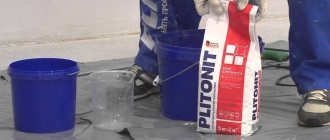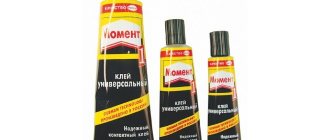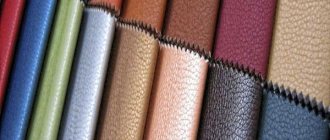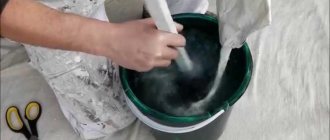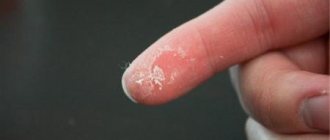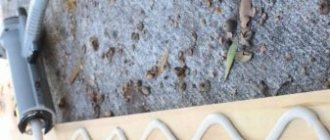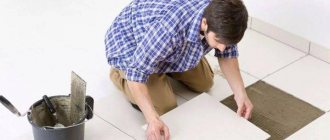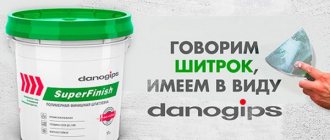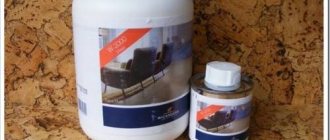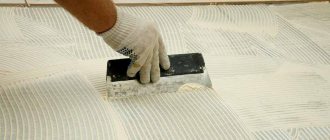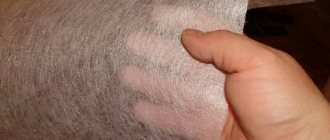There are a large number of materials on sale for thermal insulation work, among which penoplex occupies a special place due to its advantages. The material provides good surface insulation and is easy to work with. But it is important to choose high-quality glue for penoplex so that the installation result lasts for many years. It is the adhesive solutions for this material and their features that will be discussed in the article.
Peculiarities
Penoplex is a foam type material that has a homogeneous, uniform structure of small air cells. Only 2 types of this material are available to buyers, differing in density - 35 and 45 kg/m³.
They differ in many characteristics, properties, technological qualities and purpose:
- Penoplex with a density of 35 kg/m³ is used for industrial purposes and can provide thermal insulation in residential premises.
- Penoplex with a density of 45 kg/m³ is used in the construction of highways, the construction of oil and gas pipelines, as well as railway construction.
The material can also be used for less significant purposes, such as insulating the foundation, roof, facades, walls and interiors.
Penoplex has the following technical characteristics:
- Increased strength.
- Moisture resistance.
- Low thermal conductivity.
- Resistance to mechanical stress.
- Easy to install.
- Reduced chemical activity.
- Fire resistance.
- Ecological cleanliness.
- Long service life.
- Reasonable price.
Penoplex is installed using specialized tile adhesive. If you choose the right adhesive mixture, the service life of the material will increase, and it will also ensure safety for the health of people who are often indoors or live in the house.
Preparing the walls
Before gluing polystyrene foam to the wall, you need to make sure the surfaces you will be working with are ready. Due to its strength, penoplex can be attached not only to walls, but also to foundations, which will subsequently be covered with soil.
The surface of the walls must be clean. Residues of paint and varnish materials must be removed from it if the building has been painted.
The planes must be smooth and free of holes and depressions, since moisture will collect in the latter. Under certain weather conditions, this may cause a violation of the integrity of the insulating layer. Therefore, the walls must be primed and all existing defects smoothed out with putty or sand-cement mortar.
If the wall is built of loose, loose material, before gluing the penoplex to the wall, it must be plastered, creating a flat and solid base for the insulating boards. After completing all preparatory work, the surfaces must be treated with a primer.
Types of adhesives
Basically, all substances in hardware stores intended for gluing penoplex with various substrates have a high degree of adhesion, provide good adhesion for many years and improve the quality of finishing. Each manufacturer of adhesive compositions tries to indicate on the packaging the main technical parameters for the operation of the product. These include the permissible temperature range for application and further use, optimal air humidity, and suitable types of surfaces.
It is worth considering in more detail all the types from the existing range and based on this, draw a conclusion which glue will suit you best for the job.
Bitumen mastic
Bitumen mastic has a thick consistency, can be used even in frost, and retains its properties. Bitumen-based substances are actively used in construction, often for waterproofing foundations. You can glue it to the mixture in accordance with its intended purpose or fill the joints between glued penoplex with it. In this case, it will act as an excellent hydrophobic filler.
It will be convenient to glue the slabs with such a thick mixture using a spatula or spatula.
It is important to know! Mastic provides a high level of adhesion of the material to a metal or mineral base. In this case, the substance does not need shrinkage.
Liquid Nails
This adhesive mixture can be called universal, since it can glue any substrate. However, you need to consider where the surface is located - externally outside or inside. For interior work, standard compounds are suitable; for outdoor insulation, you need to choose specialized products that have good frost resistance and can withstand temperature changes.
Liquid nails are sold in convenient tubes. To ensure good adhesion, glue should be applied to the slabs in a snake pattern over their entire surface. Setting time is 10-20 seconds. But, compared to other substances, liquid nails are a more expensive material.
Mineral
If you don’t know how to glue penoplex to concrete, pay attention to mineral compounds. They are sold in the form of a dry powder, which must be diluted with water, observing the proportions, to the required consistency. They have a high degree of adhesion and allow you to work not only with concrete, but also with gas silicate and brick. Mineral glue has high plasticity and is economical in consumption. To ensure high quality gluing, applying a thin layer is sufficient. To apply, you will need a notched grater. Does not shrink after drying, remains in its original volume. Mineral adhesive for penoplex for exterior use is moisture and frost resistant.
Polyurethane
Polyurethane adhesive can usually be found in convenient metal cans that are easy to work with using a construction gun. It allows you to apply dosed glue in an even layer onto the penoplex. It would be correct to lay it out in zigzags so that the area is covered evenly. Polyurethane adhesive for penoplex sets quickly in half a minute, provides a strong connection, but quickly loses elasticity and hardens completely after 15 minutes.
Using polyurethane glue
When thinking about how to glue foam plastic to metal, the consumer quite often chooses polyurethane glue; it is the most suitable for carrying out this work. The mixture is available in convenient cylinders, but you will also need a mounting gun. If the work is single, then it is best to purchase a cheap tool, because it will not be used constantly.
Manufacturers and reviews
Let's look at the most popular manufacturers of foam adhesives.
Tytan
Polish manufacturer Selena produces high-quality products at a good price. It offers Tytan adhesive sealants and universal compounds.
To glue penoplex to various materials, it is better to use the Professional Styro 753 series, which allows you to work outside, as it is highly resistant to precipitation, temperature changes, and moisture. When working with this glue, the tightest possible fit of materials is ensured.
Cerisit
Ceresit is a popular and sought-after brand that has released compositions that allow you to stick penoplex on walls, ceilings or other surfaces.
The assortment includes a whole line for working with this material:
- Ceresit ST 84 is a construction foam for penoplex, which is used in facade cladding. She is not afraid of both sub-zero temperatures from -10 ° and heat up to +40 °. Dries very quickly, especially in summer, in 2-4 hours. It is convenient to use a mounting gun.
- Cerisit ST 83 is sold as a dry mixture. The material dries completely in only 3 days, if conditions for air temperatures in the positive range are observed. It is convenient to work with the composition with a notched spatula. On average, 6 kg/m² is consumed. The disadvantage of this substance is that it does not respond well to cold weather; it is not recommended to work with it in such conditions.
- Cerisit CT 85 is a special adhesive that is used for joining and reinforcing slabs.
This composition can also be used in warm conditions from +5 to +30 °C. The mixture is sold dry. Therefore, first you need to dilute it with water, let it sit for 2 hours, and only then apply it to the materials. For conventional gluing, the consumption is 6 kg/m², and for reinforcement – 5 kg/m².
"Moment"
The “Moment” adhesive composition will allow you to attach penoplex to anything. A universal composition will glue the material better; it can also be used as an alternative to substances for creating a reinforcing mesh. It has a good level of adhesion, high elasticity, frost resistance and moisture resistance. It does not need shrinkage and can withstand temperature changes.
Master Termol
The Master Termol brand produces an adhesive mixture to provide foam insulation systems.
It combines cement-sand components and has many advantages, including:
- Good adhesion to walls made of cement, concrete and lime materials.
- High level of adhesion to polystyrene foam.
- High plasticity of the glue.
- Frost resistance.
- Ecological purity of the composition.
Master Termol can glue the necessary materials to each other with high quality and at the same level as products from a more expensive category.
ProfLine ZK-4
The ProfLine ZK-4 variety contains special substances that increase the level of adhesion between the base and penoplex. Allows you to work even with plastered bases, as well as cement and concrete. After complete hardening, the glue is not affected by moisture, frost, mechanical and other external factors. The adhesive product is produced from high-quality raw materials.
Penoplex Fastfix
A professional construction composition simplifies the process of attaching penoplex, makes the adhesion high-quality, reliable and durable. Penoplex sheets can be easily attached to concrete, aerated concrete, ceramics or brick. But it is not suitable for foil bases. Also, do not glue penoplex to silicone, Teflon, polyethylene, bitumen.
Tips for use
To make the process of thermal insulation of your home effective, comfortable and economical, you should take into account some professional advice:
- For beginning craftsmen, use the mixture in aerosol cans and avoid using quick-drying compounds, since mistakes made are difficult to correct.
- Make calculations on the amount of glue required, taking into account the information indicated on the packaging. Purchase material with a reserve, since more mixture is wasted on surfaces with defects.
- Follow the manufacturer's recommendations for diluting dry mixtures and their use.
- Apply the composition no more than 2-3 mm. The increased amount of material will not make the fastening stronger, but will lead to costs.
- Level the penoplex immediately after contact with the surface, without waiting for the glue to set.
- Take precautions when working with hazardous compounds.
Taking into account the recommendations of professionals and purchasing high-quality materials, even an inexperienced builder will be able to carry out insulation quickly, reliably and efficiently.
Today there is no consensus on which adhesive mixture is best suited for installing penoplex. It is necessary to make a choice based on the characteristics of each specific situation. By taking care of thermal insulation at the time of building a house, it will be possible to reduce the consumption of building materials and make the process less labor-intensive.
How to choose for different surfaces
For each type of surface, you need to choose your own suitable type of substance to glue foam boards:
- For outdoor work, it is better to choose dry mixtures that have good adhesion to stone, brick and plaster. When choosing, you need to pay attention to the packaging, namely, its integrity and the indicated release date. The seal must be maintained.
- To ensure waterproofing of seams and surfaces, you need to choose bitumen or polymer adhesive.
- Polyurethane types are mainly used for reinforced concrete and wood.
- Liquid nails, polyurethane foam or silicone-based sealant provide good adhesion to metal bases.
- To install penoplex on plastic, corrugated board or plywood, it is also better to use liquid nails.
Note! If the finishing of heat-insulating materials is carried out both on the walls and on the ceiling, then for these purposes it is better to choose polymer compounds.
Polyurethane adhesives are excellent for installing materials indoors, as well as for creating floor thermal insulation. To glue penoplex outdoors, mineral adhesives are suitable.
Adhesive foam is considered a universal material used for finishing walls, indoor and outdoor surfaces. Suitable for working with floors and ceilings.
Installation methods
There are several installation methods; the choice of one or another depends on the installation location. Here they are:
- using polyurethane foam;
- using disc dowels;
- using special glue.
The use of dowels is advisable when the facade is insulated, which will later be finished with facing material. In this case, the insulation will be the basis of the subsequent design.
As for polyurethane foam, it is used when laying the material on the floor, and the latter must be of the poured type. In other cases, it is faster and easier to lay penoplex on glue.
Note! It is recommended to use only the adhesive that is intended specifically for this type of work.
Product price characteristics
Glue brands with their approximate consumption and price characteristics:
| Glue brand | The basis | Consumption per 1 m2 | Price |
| ATLAS STOPTER K-20 kley | Mineral | 4.5 kg | 1 bag of dry mixture – 310 rub. |
| Polyurethane adhesive "TITAN" | Concrete products | 0.75 l | tube – 405 rub. |
| "CERESIT" (ST83) | Any | 5 kg | 1 bag 25 kg – 375 rub. |
| "T-Avangard-K" | Needs waterproofing | 5 kg | Packaging 25 kg – 270 rub. |
| ALLFIX | Any | 0.5-0.8 kg | 1 kg – 230 rub. |
Dry adhesive mixtures
Before use, dry adhesive mixtures are diluted with water and thoroughly mixed using a hammer drill or electric drill with a special mixer attachment. The mixture dries out quickly, so it must be mixed in small quantities as it is used.
The resulting composition must have high adhesive properties to substrates such as concrete, brick or gas silicate. The solution should be quite elastic, since it is applied to polystyrene foam boards in a thin layer using a toothed grater - a “comb”, and when drying it should not decrease in volume or “shrink”.
In addition to this method, the glue can be applied in strips or dotted in two rows, departing from the edge of about 10 cm, with a step between “dots” of about 30 cm. For street work, such mixtures require high moisture and frost-resistant characteristics.
How to glue penoplex
When choosing a method for gluing penoplex, depending on the type of base:
- Striped, when the glue must be applied around the perimeter of the base in even stripes, maintaining a distance of 20 cm from the edge. The slabs must be glued carefully and carefully to avoid the formation of air pockets that impair thermal insulation.
- The beacon method, in which a strip is drawn around the perimeter of the slab and the center is filled pointwise.
- Continuous - the glue is distributed evenly on the surface of the slabs with a notched trowel.
To properly glue penoplex, you need to first prepare the base, clean it of dirt, apply a layer of primer, and wait for it to dry completely. To enhance adhesion, you need to glue the surface of the penoplex board, pre-treated with sandpaper. You should not apply glue at the junction of the insulation; EE tape is used for this purpose.
Penoplex gluing technology (2 videos)
Types and use of adhesives for penoplex (22 photos)
Choosing adhesive for foam plastic
If you are faced with the question of how you can glue foam to metal, then you should consider several methods, each of which involves certain material investments. The most budget-friendly option is the one that involves the use of PVA glue. If you have previously carried out repair work, then you may still have this composition. In this case, you do not have to purchase additional glue; you can use the leftovers. The secret to using PVA is to use burlap, which is soaked in the mixture, laid on metal, to which foam boards are then glued. In this case, it will be possible to achieve high adhesion, so that in the future it will be possible to apply a sufficiently thick layer of plaster.
Conclusion
As you can see, choosing glue for penoplex is not a problem now. I talked about those compositions that I encountered myself, but besides them there are many other worthy compositions. If you still have questions, write in the comments, I will try to help.
"Penoplex" is currently considered one of the highest quality slab insulation materials.
Penoplex is a building material that is used for insulation and thermal insulation of various surfaces and rooms. To fix the slabs to the bases, special adhesives are used, which are available in a wide range. To ensure long-term quality and reliability of the material, you need to know how to choose the right adhesive for penoplex among the existing variety.
Conclusion
All options and adhesives have their advantages and disadvantages. Each one is good in its own way. Which thermal insulation technology and adhesive solution to choose is up to you to decide.
Slab insulation produced under the Penoplex brand is now very popular and naturally people have a lot of questions about this material - which glue to use for penoplex for external use, and which for internal use? What types of compositions are there, how to fasten the slabs and a lot more similar ones. Let's try to answer the most frequently asked questions together.
Penoplex glues easily, the main thing is to choose a good glue.
First of all, remember: “Penoplex” is a brand name, and not a separate type of insulation. The material itself is called extruded polystyrene foam, it is made on the same basis as polystyrene foam, only using a different technology (extrusion method).
